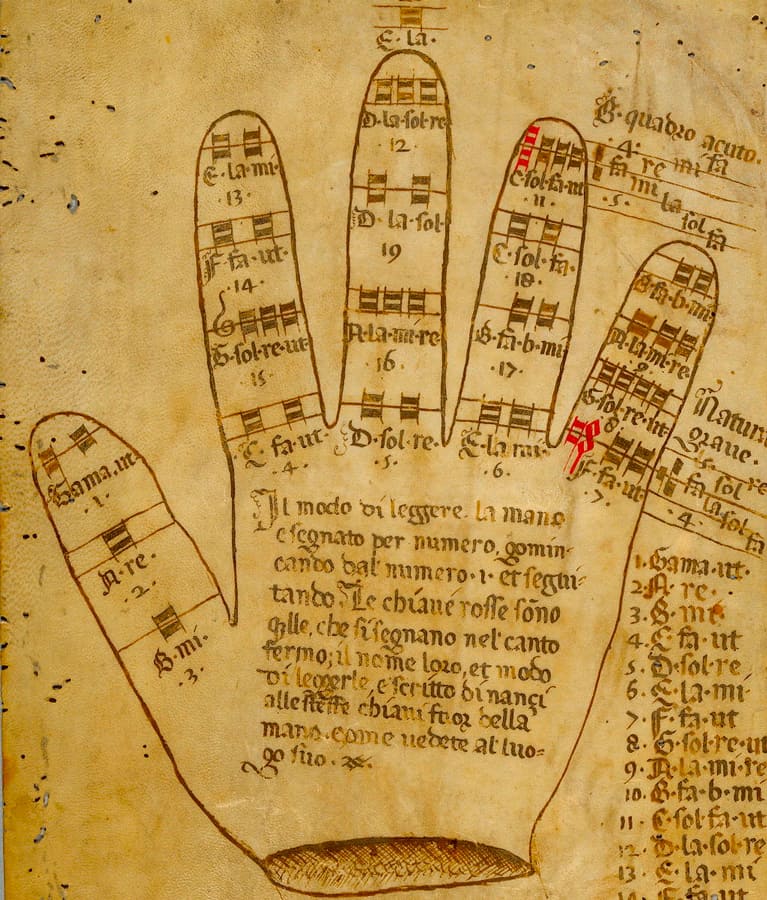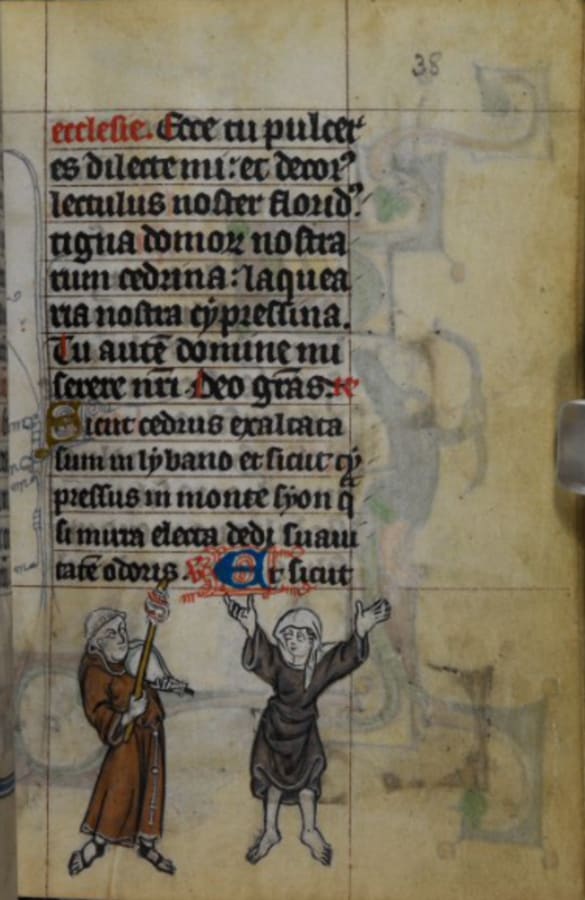Music was an important aspect of Medieval life, particularly in the celebration of the Christian faith.
Medieval Musical Notation
During the early Medieval period, musical notation was a series of symbols drawn over the text to denote changes in pitch. These symbols of dots and lines were an early form of musical notation known as neumes and were used in the plainchant songs of the Church.

As musical notation evolved in the Middle Ages, red guiding lines and more complex symbols to indicate pitch appeared.
This section of a folio of music from a 15th century manuscripts reveals music notation closer to how we see modern music written.

Tools for Reading Medieval Music
Reading was an elusive ability during the Middle Ages (Main, 2017). Most people, even monks, were unable to read. Most music was designed to be sight-read and manuscripts contained tools for assisting with this.
An example of a tool to assist with “reading” music was the use of the “Guidonian hand” drawing. This drawing denoted the different musical notes on different places of the hand to let the singer know which notes to sing. These hands mostly appeared in 12th and 13th century music books (Buja, 2015).

Medieval Music and the Church
For the Church, music outside of religious devotion was often considered sinful. Marginalia from religious texts such as this miniature from a Dutch Book of Hours.
The monk is playing a violin-like instrument with a weaving tool while the nun is shown wantonly dancing with her robe scandalously hiked up past her knees (British library, n.d.).

Medieval Musical Instruments
Common medieval instruments included the harp, the lute, bagpipes, the hurdy-gurdy, the psaltery, and the lyre. Musical intruments were developed for two main purposes in the Middle Ages. One group, mostly string instruments, were developed for quieter indoor music (British library, n.d.). Outdoor music for playing at fairs and processions included trumpets, drums, and bagpipes.
Antiphonal
Particularly during the early Middle Ages, music was created to be sung as part of both private and public worship. The antiphonal is a book of chants used for the recitation of the Divine Office. The words stems from the Latin word antiphōna meaning ‘sounding in response.’ The chants involved a call and response style of song. Monks would gather around a large book that was designed to be sight-sung.
Polyphony
Polyphony is the combining of multiple singing parts to create a harmony.
“Congaudeant catholici” (Let all Catholics rejoice together) is a composition found in the 12th century Codex Calixtinus (a travel guide for pilgrimages) that contains the first known composition for three voices, making it an early example of polyphony (Codex Calixtinus, n.d.).
Non-Religious Medieval Music
This cordiform manuscript was created for a French nobleman, Jean de Montchenu, in 1470. The heart-shaped design reflects the forty-four polyphonic chansons about love and represents a non-religious musical manuscript.
Close up of the musical notation. The word for heart (cuer) is replaced by the pictogram ♡
Emerging Renaissance Music
The mid-15th century poetry manuscript, ‘Le Champion des Dames‘ (The Champion of Ladies) contains the earliest signs of the emerging renaissance music. While the manuscript is a 24,384-verse composition of poetry about women, the book also devotes six stanzas to the state of music at the time.
This illustration shows the Nine Muses, playing on instruments such as the organetto, double pipes, slide trumpet, and triangle.
References
British library. (n.d.). Friar playing music. Retrieved from http://www.bl.uk/learning/timeline/item100377.html
Buja, M. (2015, June 2). A helping hand with music [Blog post]. Retrieved from http://www.interlude.hk/front/helping-hand-music/
Codex Calixtinus. (n.d.). Retrieved from http://scholar.library.miami.edu/facsimile/calix.html
Main, L. (2017). Lecture on the Medieval Literacy. Personal Collection of L. Main. San José State University, San José, California. Retrieved from http://amazon.sjsu.edu/html-lmain/presenter/medworld/index.htm
